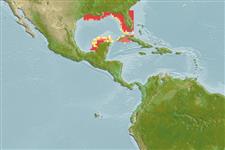Klassifizierung / Names
Namen | Synonyme | Catalog of Fishes (gen., sp.) | ITIS | CoL | WoRMS | Cloffa
Actinopterygii (Strahlenflosser) >
Clupeiformes (Herrings) >
Clupeidae (Herrings, shads, sardines, menhadens) > Alosinae
Etymology: Brevoortia: From James Carson Brevoort (1818-1887), studie the fauna from Ohio and South Caroline (Ref. 45335). More on author: Goode.
Lebensraum / Klimazone / Range
Ökologie
; seewasser; tiefenbereich 0 - 50 m (Ref. 188). Subtropical, preferred 24°C (Ref. 107945); 31°N - 19°N, 95°W - 80°W (Ref. 54290)
Western Central Atlantic: Gulf of Mexico (Florida Bay, Gulf of Campeche, Mexico), but no certain records from Caribbean.
Length at first maturity / Size / Gewicht / Alter
Maturity: Lm ?, range 15 - 22.5 cm
Max length : 35.0 cm SL Männchen/unbestimmt; (Ref. 7251); common length : 20.0 cm SL Männchen/unbestimmt; (Ref. 188)
Rückenflossenstacheln (insgesamt): 0; Afterflossenstacheln 0. Scutes along belly; upper jaw with median notch. Pelvic fin with rounded hind margin, inner fin rays equal or nearly equal to outer fin rays when fin folded back. Pre-dorsal scales modified; scales in lateral series large, those on back and above anal fin base a little smaller and more irregular than rest. A black spot behind gill opening, followed by a series of spots along flank (Ref. 188). Back bluish gray, Sides brassy green (Ref. 37032).
Occur inshore in summer, but at least some moving into deeper waters from October (Mississippi Delta area). Feed in dense schools, filtering phytoplankton, but probably also feed at the bottom. Apparently breed in winter (October to February, with a peak in January). Salinity tolerance range from 0.1-60 ppt, but the commercial catch is mostly from 5.0-24 ppt. Marketed fresh, salted or canned. Mainly used as source of fish oil; also as fish meal (Ref. 188). Isopod is found in the mouth (Ref. 37032).
Make inshore-offshore movements (Ref. 34923). Larvae stay in offshore waters for 3-5 weeks before moving into estuaries where they grow into adults (Ref. 34923).
Whitehead, P.J.P., 1985. FAO Species Catalogue. Vol. 7. Clupeoid fishes of the world (suborder Clupeioidei). An annotated and illustrated catalogue of the herrings, sardines, pilchards, sprats, shads, anchovies and wolf-herrings. FAO Fish. Synop. 125(7/1):1-303. Rome: FAO. (Ref. 188)
IUCN Rote Liste Status (Ref. 115185)
CITES (Ref. 94142)
Not Evaluated
Bedrohung für Menschen
Harmless
Nutzung durch Menschen
Fischereien: hoch kommerziell
Tools
Zusatzinformationen
Download XML
Internet Quellen
